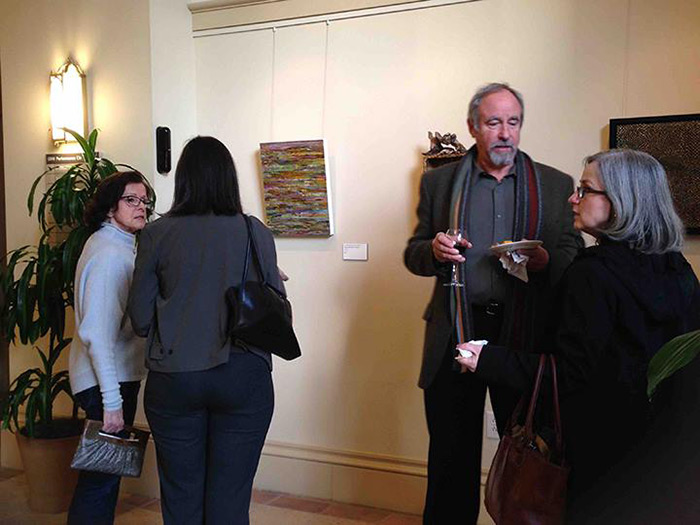The exhibition “In-Visible,” on display in Point Park University’s Lawrence Hall, features works by nearly two dozen members of the National Association of Women Artists.
The exhibit was juried by John Carson, head of Carnegie Mellon University School of Art, who chose the mixed-media piece “Billie Holiday Wears a Veil Gifted by John Rawls” as best of show.
The work is part of a series created by Caroline Rust of Charlotte, N.C., as a tribute to women throughout history.
“Billie Holiday, the woman, represents injustice due to color of one’s skin. Though it was her experiences that contributed to her talent and added depth to her expression,” Rust says.
Philosopher Rawls put forth the veil of ignorance theory as a method for determining morality of a specific issue. In the thought experiment, people had to determine whether an issue such as slavery was morally correct, without knowing their place in society, such as whether they were a slave or master.
What makes the painting such a standout piece is the vintage veil that shrouds the portrait.
“Vintage garments have more than once provided inspiration for my artworks. So have women from history,” Rust says. “These women, with an internal power and drive, help strengthen me with the knowledge and discovery of their bravery, courage and steadfast devotion to live their lives by their terms while in the pursuit of a goal.”

“Living in New York, taxis are such a common occurrence as to be invisible,” Lippa says. “By capturing a moment, this taxi driving by Washington Square is no longer invisible, but is seen as a blur of lights. We now have the time to realize that these lights are a cab and ask ourselves, ‘Who is in this cab? Where is it going? Why is it moving so quickly?’ ”
Otherwise, the show is full of abstract and semi-abstract works. Among them, “Cosm #4: Journey to Elysia” by Leslie Tejada of Corvallis, Ore., is a real standout piece.
The piece is part of an ongoing series of experimentations with acrylic paint on wood panel. Tejada says she started it by pouring pools of thinned acrylic paint in a few successive layers, and “watching to see what happened. Then, I added some elements by hand and a few spirals created with a hand-made stencil.”
Besides the obvious connotations of the white and blue to clouds in the sky, the painting has an ethereal feeling of things dissolving and reappearing.
“In Greek mythology, Elysium, or the Elysian Fields, is the abode of the blessed after death, a place of ideal happiness,” Tejada says. “The elements in the painting are on a journey, moving up and away. They are going to Elysia.”
Surprisingly, the show has several excellent examples of abstraction in photography.
“Electromagnetics” by Leslie Ebert of Portland, Ore., is an example of her explorations with something she calls “macro digital photography,” which calls to mind the works of Mark Rothko and Claude Monet.
And “Site/Sight Unseen 18,” a pigment print from an original gelatin silver print by Jane Olin of Carmel Valley, Calif., has an ethereal quality all its own.
About her abstract photographs, Olin says, “They involve chance and a little magic. As I apply chemicals, I have no control over what happens with the print. My only sense of control is when I react to what I see and add more chemicals over time. This process often continues for hours.”
Then, there is a curious little drawing by Sue Kutosh, who lives in Manhattan. Featuring the gold silhouette of an elephant in Manhattan, it was inspired by an April morning in New York City when a large elephant sculpture was positioned in Columbus Circle.
“Looking upward, a dense morning mist made skyscrapers disappear,” Kutosh says. “But the giant pachyderm was sharply visible in the blurred environment. This moment inspired the drawing where I rendered buildings in soft tones as a stage for a dominating creature.”
Kutosh chose to interpret the bronze figure in gold leaf, “to emphasize metal within atmosphere,” she says. “The contrast is intended to magnify the animal’s commanding presence and the fleeting impression of an elephant walking through a Manhattan spring fog.”
Of course, there are many more unique and compelling works on display in this exhibit, making it well worth a visit. Congratulations to the Award Winners, In-VISIBLE
– Kurt Shaw, TRIB Live




